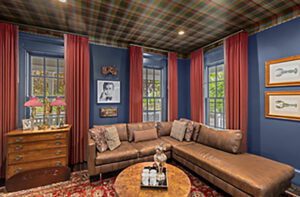The Woodsman
August 30, 2010
Text by Nathanial Reade Photography by Portrait by Chris Vaccaro
Hank Gilpin, who looks like a tall, white-ponytailed version of Larry David, is picking through a stack of boards in his shop. All of them were sliced from one white-oak log, and they’re crazy. The grain goes everywhere, around knotholes, decay, bug damage and bits of bark. Worst of all, these boards are warped, twisted, and they aren’t even rectangular, the way you’d expect a board to be; they’re shaped more like a series of boomerangs. Most woodworkers, once they squared and planed these pieces into workable boards, would be left with enough to make some legs, or maybe some cutting boards. Gilpin, however, is turning them into garden-room shelves and cabinets for a client.
Gilpin’s furniture sits in the Peabody-Essex Museum in Salem, Massachusetts, the Rhode Island School of Design Museum in Providence and the Museum of Fine Arts in Boston. He has billionaire clients who never ask for a preliminary sketch or a cost estimate: they just let him make them things, and when he’s done he sends them a bill, which they pay without question. Contemporary, artisan-made furniture is a thoroughly underappreciated art form—only a handful of furniture-makers earn a living at it without the support of a faculty salary, a trust fund or a spouse—and he’s in that handful. He built virtually all the furniture in the Boston Golf Club, some of it from trees he cut and milled on the property. And he’s gotten to this lofty spot not because of his personality (the first time I interviewed him he growled, “I think you’ve got enough” after forty-five minutes and sent me on my way) or his marketing skills (until recently he wouldn’t bother with most gallery shows, didn’t sign his work and refused to send out photographs to prospective clients because he said no two-dimensional image could do justice to his three-dimensional shapes). Unlike such big-name furniture artisans from the past as George Nakashima or Gilpin’s contemporary Judy Kensley McKie, he doesn’t have a recognizable style or brand; you don’t look at a piece and instantly say, “That’s a Hank Gilpin.”
So why has he succeeded? Because he’s “the wood guy.” He answers the phone “Gil’s World of Wood,” and signs his work “GWOW.”
You’d think that everybody who decides to make things out of wood, as opposed to steel or plastic, would be a wood guy or girl, and to an extent the others are. Gilpin, however, studies wood constantly. He has a shark-like hunger, but his appetite is for more information, all the time. He slices open rotten fence posts to study the heartwood; he’s read thousands of books on the subject. He’s got a little arboretum outside his kitchen door, where he points and recites Latin names. He’s virtually the only person who would have bought that pile of boomerang-shaped white-oak boards. He says, “There’s no such thing as bad wood.”
Case in point: Gilpin has already cut two pieces from that weird white oak for the cabinets in the gardening room. He says, “There’s your doors.” Except that they don’t look like doors: each is shaped like a preschooler’s version of the letter D. The tops of the doors meet, but at the bottom they leave an opening that looks like a random, squiggle-sided pyramid. He likes that. He shows me the worktable he has already made for this room, which has a similar, smaller, squiggly cut-out. It’s gorgeous. It’s alchemy. How did he do it? It’s almost as if the tree told him. “I let the shape of the wood tell me how to think about this,” he says.
Gilpin has marched down his own path to some distant drummer virtually from the day in 1973 that he bought an old church in Lincoln, Rhode Island, and began filling it with wood-working tools. Everybody else was making furniture out of traditional woods: mahogany, teak, cherry. It was mostly imported, and mostly expensive. Gilpin figured that if he was going to make money at a time in his career when he was selling intricately constructed side tables for less than $200, he was going to have to stop shopping at fancy wood stores and start buying his wood from local sawmills. He began to specialize in what he calls “under-utilized local species,” such as maple, beech and white oak. It worked.
As he cruised the small sawmills of New England in his red pick-up looking for wood that spoke to him, local foresters and loggers showed him other species that could make fine furniture but didn’t grow in sufficient quantities to be mass-marketed: poplar, ash, birch, locust, buckeye. This lead him to all the variations in those local trees—the ones that for no known reason developed unusual, tiger-striped, curly, blistered or quilted grains. Then he discovered boards that were alleged to have things wrong with them. Beech, for instance, has a pale white color, like the flesh of an apple, but it can develop a black stain, called spalting, that runs through it like veins. For a famous Hollywood comedian (he refuses to name client names), Gilpin built a chest with doors composed of spalted beech in crazy-quilt fashion, the stain composing a black-on-white painting.
Some furniture artists do variations of the same thing over and over again. That’s how they develop a recognizable style or brand. Gilpin’s idea of hell is “One. More. Cherry. Board.” He deliberately juggles ten jobs simultaneously, and constantly seeks new challenges. Once he’d figured out how to use all these strange local species and their strangely stained or grained variations, he started picking through the dumpsters at sawmills and bringing home wood that had been tossed out for being too warped, crooked, twisted or bent, like a rescuer of stray cats. He remembers the day it started, at a sawmill in the Berkshires. He says, “I was looking at a board on a pile with a big arc in it. You couldn’t mill it, you’d lose it all, but it was beautiful. I said, if I just hand-sand this I can use it. And that was the beginning.”
He shows me a two-foot-wide plank of curly white oak that he bought in Ohio, as curved and concave as an orange peel. I say, “Maybe it could be a headboard?”
In his slightly contemptuous teacher voice he says, “It doesn’t have to be anything. It is what it is. It’s this outrageous piece of wood. It’s like an interior landscape: You just wanna look at it.”
Yes you do.
Editor’s Note Hank Gilpin can be reached at (401) 334-2638, or e-mailed at gwow@cox.net.
Share
![NEH-Logo_Black[1] NEH-Logo_Black[1]](https://b2915716.smushcdn.com/2915716/wp-content/uploads/2022/08/NEH-Logo_Black1-300x162.jpg?lossy=1&strip=1&webp=1)





















You must be logged in to post a comment.